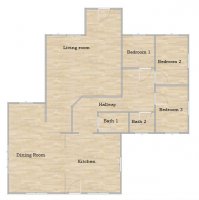smyke
New Member
Hello,
I had a thread going in the Water Heater section and some questions had been answered there but per Dana's recommendation I am starting a new thread here to help me figure out what I need to do.
I just purchased a house knowing that the heating will need to be updated.
Electric company did an audit yesterday and found the existing boiler to be 83% efficient (Utica POBT-5 that is rated at 161700BTU).
They did not do a blower door test since I have vermiculite insulation in the attic. Its all covered with plywood but apparently the test cannot be performed for obvious reasons. I didn't know that. If I get the vermiculite tested and if it is asbestos free then they can come out and test. We'll see.
House is a single story ranch with the mentioned attic and a basement that contains 2 single-car garages (separate doors). There is no insulation on the ceiling in the basement.
There are 2 heating zones in the house. One (older section built in 1955) covers about 1060 sq ft (living room, 3 bedrooms, 2 baths and a hallway) with 950" (80') of 1" baseboard. Second zone (addition built around 1975) covers 560 sq ft (kitchen and dining room) with 479" (40') of 3/4" baseboard.
Lady that has been living there since day one liked to keep it pretty warm from what I understand. She had used almost 1000 gallons of oil over the last year. I am attaching the delivery info I received from the oil company.
There is an electric water heater (AO Smith ECT52) that has the incoming water preheated by the boiler.
My initial plan was to convert to natural gas (line at the street, gas company will hook up the house for free) and using a Bosch Combi unit but I am open to other options.
For cooling I was thinking about mini-split system that heats also and use that as supplement to oil or vice versa.
We may just go one winter with everything as is and go from there.
I had one quote done for Bosch (they didnt even give me any other options) for $9000. Their estimate was 52000BTU.
I am in the process of calculating the heat loss with the Slant/Fin but its a bit of a PIA to use.
Any and all help will be greatly appreciated.
Mike
I had a thread going in the Water Heater section and some questions had been answered there but per Dana's recommendation I am starting a new thread here to help me figure out what I need to do.
I just purchased a house knowing that the heating will need to be updated.
Electric company did an audit yesterday and found the existing boiler to be 83% efficient (Utica POBT-5 that is rated at 161700BTU).
They did not do a blower door test since I have vermiculite insulation in the attic. Its all covered with plywood but apparently the test cannot be performed for obvious reasons. I didn't know that. If I get the vermiculite tested and if it is asbestos free then they can come out and test. We'll see.
House is a single story ranch with the mentioned attic and a basement that contains 2 single-car garages (separate doors). There is no insulation on the ceiling in the basement.
There are 2 heating zones in the house. One (older section built in 1955) covers about 1060 sq ft (living room, 3 bedrooms, 2 baths and a hallway) with 950" (80') of 1" baseboard. Second zone (addition built around 1975) covers 560 sq ft (kitchen and dining room) with 479" (40') of 3/4" baseboard.
Lady that has been living there since day one liked to keep it pretty warm from what I understand. She had used almost 1000 gallons of oil over the last year. I am attaching the delivery info I received from the oil company.
There is an electric water heater (AO Smith ECT52) that has the incoming water preheated by the boiler.
My initial plan was to convert to natural gas (line at the street, gas company will hook up the house for free) and using a Bosch Combi unit but I am open to other options.
For cooling I was thinking about mini-split system that heats also and use that as supplement to oil or vice versa.
We may just go one winter with everything as is and go from there.
I had one quote done for Bosch (they didnt even give me any other options) for $9000. Their estimate was 52000BTU.
I am in the process of calculating the heat loss with the Slant/Fin but its a bit of a PIA to use.
Any and all help will be greatly appreciated.
Mike


